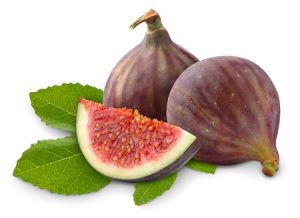For me, figs are only ever eaten in hot Mediterranean countries but we can grow them with some success in more northerly European climates. One variety in particular ‘Brown Turkey’ is a real stalwart and in recent years with climate changes has started to generate substantial crops in the south of the UK. In fact figs are extremely easy to grow even with sowing seeds.
Most fig trees are grown against walls where they are afforded some protection from northerly winds. Ours faces West which means there is sometimes frost damage but it doesn’t affect the overwintering fruits. Whilst I know of some other varieties that can be grown in the UK, ‘Brown Turkey’ which is an AGM winner is probably our most successful and I’ve seen them growing now as far as Yorkshire.

Success Factors
Figs need sunshine and heat. Choosing a good site as with any fruit tree is key to success. Good soil, plenty of room to expand and the fig simply grows rampant with lots of leaf and little fruit. The other success factor is restricting the roots such that the fig starts producing these rather than masses of fruit. Growing against a wall helps to a certain extent but some of the best yields are obtained from pot and container grown trees. The roots really do need to be starved so little feeding and indeed watering is useful. I’ve seen a number in Italy growing in almost semi-arid conditions but thriving where no other could manage it.
It’s also desirable to have shallow soil for these trees. they quite enjoy growing above a shallow bed of rock like limestone. I use poor top soil which hadn’t been fed for years and the base was also cement infill from a building project. Growing under stress is really what a fig likes.
If you want to recreate conditions for figs but have the best garden soil and growing conditions in the world, then a sunken container is the way forward. A wooden box of 60cm by 60cm will work which is filled with the poorest soil overlaying builders rubble.
Continued Care
Fig trees really do enjoy facing west but South facing is fine too. They should be pruned regularly to keep shape and regularly take off the lowest branches to allow light and to let me as harvester get at the fruit which sometimes forms in the most impenetrable places. Any other young growth is tied back where there are gaps or left when old branches are taken off. If you have starvation, root restriction and some judicious pruning, then fruit should follow.
Most figs will produce two harvests every year. Given the short length and coolness of our summers in the UK, the second harvest will not often come. It is best to remove the second crop although I leave these for the birds or other animals to chew on in winter months.
When the leaves come off in autumn, I remove most of the remaining figs although these will also ripen earl next year, give or take a bit of frost damage. When spring finally reappears these fruit that survived will race away and cropping will start mid-August and into early September just.
Container Growing
Pot cultivation is a successful technique for growing figs because of severe root restriction. However, do not be too restrictive as the pot just becomes roots. The container is first filled with John Innes No. 1 compost and watered before the tree begins to look over-stressed. the best pots are 45 to 60cm diameter and terracotta ones are ideal for this purpose. If the winter is cold, wrap the pot with bubble wrap and hessian as you would a dwarf banana. The roots are tender. I also place it against a south facing wall where it then has to take its chances. Having said that, its remarkable how robust they are.
Leave a Reply